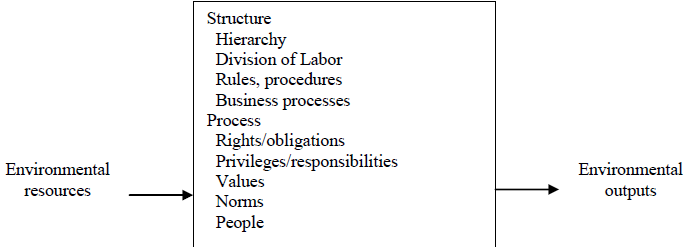Organization is a stable, formal social structure that takes resources from the environment and processes them to produce outputs (technical definition). This technical definition focuses on three elements of an organization:
- Capital and labor are primarily production factors provided by the environment.
- The organization (the firm) transforms these inputs into products and services in a production function.
- The products and services are consumed by environments in return for supply inputs.
The illustration below shows the relation between these three elements. In the technical microeconomic definition of the organization, capitol and labor (the primary production factor provided by the environment) are transformed by the firm through the production process into products and services (output to the environment). The products and services are consumed by
the environment, which supplies additional capital and labor as inputs in the feedback loop.
- An organization is more stable than an informal group in terms of longevity and routine-ness. Organizations are formal legal entities, with internal rules and procedures, that must be abide by laws.
- Organizations are also social structure because they are a collection of rights, privileges, obligations and responsibilities that are delicately balanced over a period of time through conflict and conflict resolution (behavioral definition).Figure 4.3 below shows the behavioral view of an organization that emphasizes group relationships, values and structures.

From the technical view of organization, it encourages organization to focus upon the way inputs are combined into outputs when technology changes are introduced into the company. The firm is seen as infinitely malleable, with capital and labor substituting for each other quite easily. Meanwhile, from the behavioral view of organization, it suggests that building new information systems or rebuilding old ones involves much more than a technical rearrangement of machines or workers.
The technical and behavioral definitions of organizations are not contradictory but they complement each other. The technical definition tells us how many thousands of firms in competitive market combine capital, labor and information technology whereas the behavioral models takes us inside the individual firm to see how that technology affects the inner workings of the organization.
Kavungya answered the question on
May 10, 2019 at 07:38